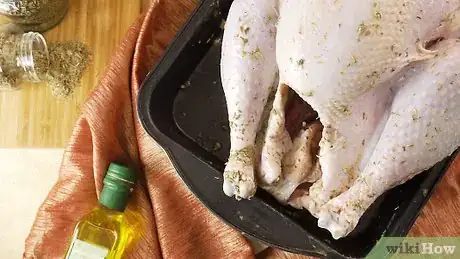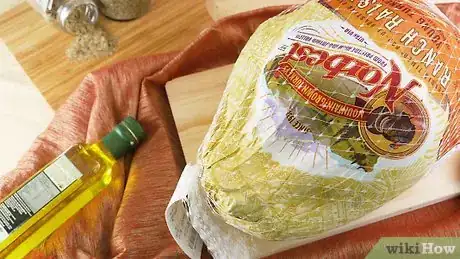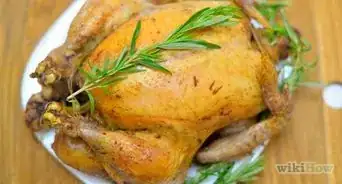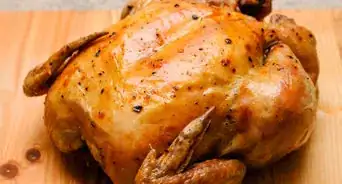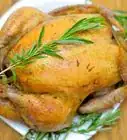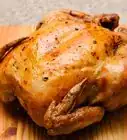This article was co-authored by JoAnna Minneci. JoAnna Minneci is a Professional Chef based in the Nashville, Tennessee area. With more than 18 years of experience, Chef JoAnna specializes in teaching others how to cook through private cooking lessons, team-building events, and wellness and nutrition classes. She has also appeared in numerous television shows on networks such as Bravo and Food Network. Chef JoAnna received Culinary Arts training from the Art Institute of California at Los Angeles. She is also certified in sanitation, nutrition, kitchen management, and cost control.
wikiHow marks an article as reader-approved once it receives enough positive feedback. In this case, several readers have written to tell us that this article was helpful to them, earning it our reader-approved status.
This article has been viewed 327,981 times.
Start seasoning a whole turkey the day before roasting for the most memorable flavor. You can season a turkey with a variety of different flavors, as well as a little salt and pepper. Once you've seasoned the turkey, you can cook it according to your recipe. You'll be left with a nice main course to enjoy with friends and family members.
Steps
Making a Seasoning
-
1Use a standard Thanksgiving seasoning. If you're making a turkey for Thanksgiving or another holiday, try a standard seasoning with some parsley and sage. This will produce a classic taste for your family to enjoy.[1]
- In a small bowl, add 1/4 cup of fresh chopped parsley. Then, add one tablespoon each of sage, rosemary, and thyme. Add two tablespoons each of olive oil and melted butter, as well as half a teaspoon of both salt and pepper. The kind of olive oil you use doesn't matter.
- Mix all your ingredients together until you have an even, uniform mixture.
-
2Try a lemon seasoning. If you want something a little different, try a lemon seasoning. This will make for a fresh, savory turkey.[2]
- Mix 1/4 cup of unsalted butter with a teaspoon of lemon zest. Then, add a teaspoon of chopped thyme and a teaspoon of chopped marjoram.
- Mix all the ingredients together into a uniform mixture.
- Mix three tablespoons of room temperature butter with two tablespoons each of rosemary and thyme.
- Mince three garlic cloves and mix them in with the butter/herb mixture.
Advertisement -
3Use a maple syrup glaze. If you want something sweeter, think about maple syrup. A maple syrup glaze can provide a somewhat unexpected but pleasant taste for your turkey.[3]
- You actually apply this mixture after cooking the turkey for two and a half hours. You will mix two tablespoons of the pan juices with 1/4 cup of maple syrup. Then, rub the mixture all over your turkey.
- Then, roast your turkey for 15 more minutes to let the flavor set in
Applying Seasoning to the Turkey
-
1Rub your mixture all over your turkey. Usually, you apply the seasoning before you cook your turkey. However, remember the maple syrup glaze is applied after the turkey's been in the oven. With other glazes, you'll rub the turkey down in the mixture ahead of time.[4]
- Use enough of any mixture you choose to cover the full surface of the turkey. Rub it all over the outside of the turkey, covering areas like the legs as well.
-
2Add your remaining ingredients inside the turkey. If you have any seasoning left over after applying a liberal layer, do not let it go to waste. Instead of discarding leftover seasoning, rub a little bit of it inside the cavity of the turkey. This will make the turkey's seasoning taste a little stronger.[5]
-
3Cook your turkey after seasoning according to your recipe. Once you're seasoning applied, cook your turkey according to your recipe's instructions. Instructions will vary, but turkeys are usually cooked around 325 degrees Fahrenheit (about 163 degrees Celsius) and are cooked for at least a couple of hours.[6]
- You will need an oven thermometer to make sure your turkey is cooked through. A turkey must have temperature of at least 165 degrees Fahrenheit to be safe to eat.[7]
Assuring a Quality Turkey
-
1Figure out how much seasoning you need. You may need to make a little more of the seasoning than the recipe instructs if you have a very large turkey. To determine how much seasoning you need, place your turkey in the container you're going to cook it in.[8]
- Slowly fill the container with water. Keep filling the container until the turkey is completely submerged.
- Remove the turkey and measure out the water. This is how much seasoning you will need.
-
2Select a quality turkey to season. Solid seasoning will not make a poor quality turkey taste good. Before you season a turkey, make sure to pick a quality turkey at the store. Go for a turkey between 12 and 20 pounds without artificial flavors or added preservatives.[9]
-
3Make sure your turkey is completely thawed before seasoning. If you purchase a turkey that requires thawing, read the package instructions. Make sure you thaw the turkey for as long as necessary. Your turkey will not cook correctly if it's improperly thawed, so give yourself enough time to adequately thaw the turkey.[10]
-
4Finished.
Expert Q&A
-
QuestionHow do you properly season a turkey for smoking?
 JoAnna MinneciJoAnna Minneci is a Professional Chef based in the Nashville, Tennessee area. With more than 18 years of experience, Chef JoAnna specializes in teaching others how to cook through private cooking lessons, team-building events, and wellness and nutrition classes. She has also appeared in numerous television shows on networks such as Bravo and Food Network. Chef JoAnna received Culinary Arts training from the Art Institute of California at Los Angeles. She is also certified in sanitation, nutrition, kitchen management, and cost control.
JoAnna MinneciJoAnna Minneci is a Professional Chef based in the Nashville, Tennessee area. With more than 18 years of experience, Chef JoAnna specializes in teaching others how to cook through private cooking lessons, team-building events, and wellness and nutrition classes. She has also appeared in numerous television shows on networks such as Bravo and Food Network. Chef JoAnna received Culinary Arts training from the Art Institute of California at Los Angeles. She is also certified in sanitation, nutrition, kitchen management, and cost control.
Professional Chef Because of the smoke, you don't need to season your turkey very much. Instead, give your turkey flavor using flavorful smokes like cherry wood or apple wood. You might also use the same flavorings you'd choose for a barbecue, like a barbecue rub you'd use for pork.
Because of the smoke, you don't need to season your turkey very much. Instead, give your turkey flavor using flavorful smokes like cherry wood or apple wood. You might also use the same flavorings you'd choose for a barbecue, like a barbecue rub you'd use for pork. -
QuestionHow long do I roast a turkey?
 Nancy JonesCommunity AnswerDepending on the weight of the turkey, you can roast it between 3-5 hours. Each turkey has a thermometer placed on the side of it. It usually looks like a flat pin. When the turkey has reached a safe internal temperature for consumption, this plastic pin will pop up and stick out of the turkey. DO NOT REMOVE THE PIN BEFORE COOKING. It will not harm the food at all and is actually there as a safety precaution. Raw consumption of food is one of the leading causes of food poisoning. Read the package on your turkey carefully before opening and cooking.
Nancy JonesCommunity AnswerDepending on the weight of the turkey, you can roast it between 3-5 hours. Each turkey has a thermometer placed on the side of it. It usually looks like a flat pin. When the turkey has reached a safe internal temperature for consumption, this plastic pin will pop up and stick out of the turkey. DO NOT REMOVE THE PIN BEFORE COOKING. It will not harm the food at all and is actually there as a safety precaution. Raw consumption of food is one of the leading causes of food poisoning. Read the package on your turkey carefully before opening and cooking. -
QuestionCan you blend all the seasonings and season the turkey?
 Nancy JonesCommunity AnswerYes. It's better to make a paste and season it that way, inside and out, as opposed to rubs, which really only lightly season the meat.
Nancy JonesCommunity AnswerYes. It's better to make a paste and season it that way, inside and out, as opposed to rubs, which really only lightly season the meat.
Warnings
- You can get sick from the microscopic bacteria on raw turkey. Wash your hands and any surfaces that come in contact with uncooked turkey.⧼thumbs_response⧽
References
- ↑ http://www.tablespoon.com/recipes/thanksgiving-turkey-seasoning/334baeaf-f3f1-44fc-a51c-907915a5a5db
- ↑ http://www.todaysparent.com/recipe/turkey/lemon-thyme-roasted-turkey-with-cider-gravy-recipe/
- ↑ http://www.chatelaine.com/recipe/world-cuisine-2/maple-glazed-turkey/
- ↑ http://www.tablespoon.com/recipes/thanksgiving-turkey-seasoning/334baeaf-f3f1-44fc-a51c-907915a5a5db
- ↑ http://www.tablespoon.com/recipes/thanksgiving-turkey-seasoning/334baeaf-f3f1-44fc-a51c-907915a5a5db
- ↑ http://www.chatelaine.com/recipe/dinner/herb-and-garlic-turkey/
- ↑ https://www.foodsafety.gov/keep/charts/mintemp.html
- ↑ http://www.spicesinc.com/p-1371-marinating-your-turkey.aspx
- ↑ http://www.spicesinc.com/p-1371-marinating-your-turkey.aspx
About This Article
To season a turkey, add 1/4 cup of chopped parsley, and 1 tablespoon each of sage, rosemary, and thyme to a bowl. Then, mix in 2 tablespoons of olive oil and 2 tablespoons of butter, followed by 1/2 teaspoon of both salt and pepper. If you’d rather have something sweeter, cook your turkey for 2.5 hours, then make a maple syrup glaze by combining 1/4 cup of maple syrup with 2 tablespoons of the pan juices. Cover your turkey with the glaze and roast it for 15 more minutes. For more tips, including how to season the inside of your turkey for the best possible flavor, read on!




